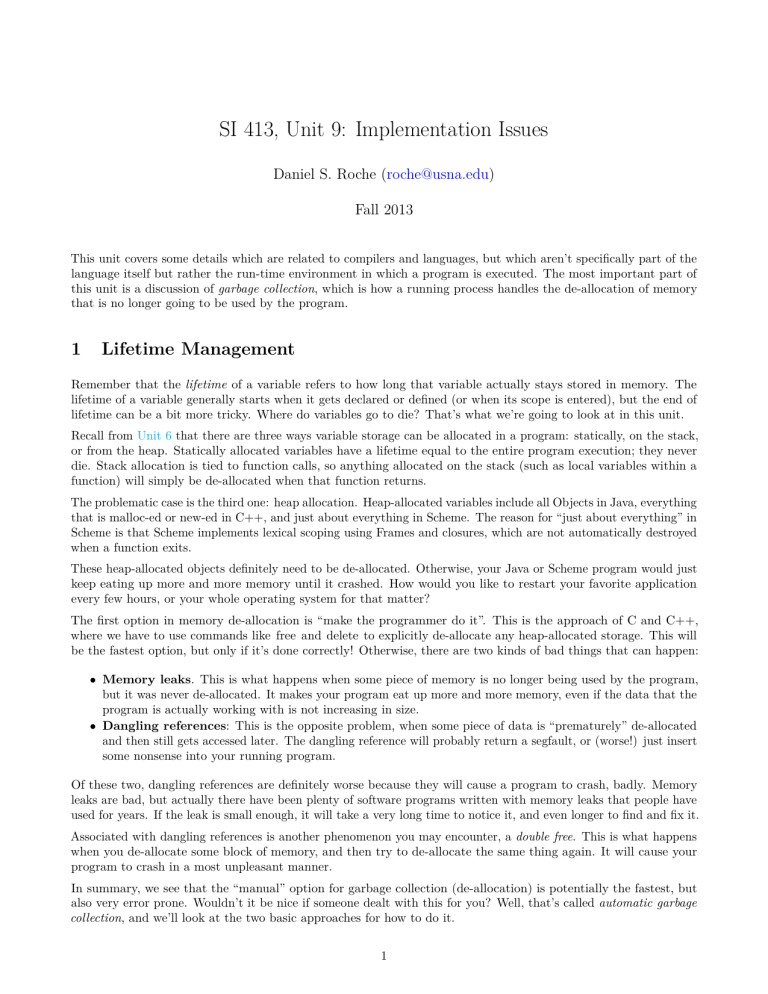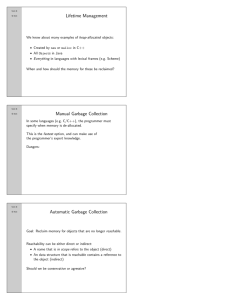SI 413, Unit 9: Implementation Issues ( ) Fall 2013

SI 413, Unit 9: Implementation Issues
Daniel S. Roche ( roche@usna.edu
)
Fall 2013
This unit covers some details which are related to compilers and languages, but which aren’t specifically part of the language itself but rather the run-time environment in which a program is executed. The most important part of this unit is a discussion of garbage collection , which is how a running process handles the de-allocation of memory that is no longer going to be used by the program.
1 Lifetime Management
Remember that the lifetime of a variable refers to how long that variable actually stays stored in memory. The lifetime of a variable generally starts when it gets declared or defined (or when its scope is entered), but the end of lifetime can be a bit more tricky. Where do variables go to die? That’s what we’re going to look at in this unit.
Recall from Unit 6 that there are three ways variable storage can be allocated in a program: statically, on the stack, or from the heap. Statically allocated variables have a lifetime equal to the entire program execution; they never die. Stack allocation is tied to function calls, so anything allocated on the stack (such as local variables within a function) will simply be de-allocated when that function returns.
The problematic case is the third one: heap allocation. Heap-allocated variables include all Objects in Java, everything that is malloc-ed or new-ed in C++, and just about everything in Scheme. The reason for “just about everything” in
Scheme is that Scheme implements lexical scoping using Frames and closures, which are not automatically destroyed when a function exits.
These heap-allocated objects definitely need to be de-allocated. Otherwise, your Java or Scheme program would just keep eating up more and more memory until it crashed. How would you like to restart your favorite application every few hours, or your whole operating system for that matter?
The first option in memory de-allocation is “make the programmer do it”. This is the approach of C and C++, where we have to use commands like free and delete to explicitly de-allocate any heap-allocated storage. This will be the fastest option, but only if it’s done correctly! Otherwise, there are two kinds of bad things that can happen:
• Memory leaks . This is what happens when some piece of memory is no longer being used by the program, but it was never de-allocated. It makes your program eat up more and more memory, even if the data that the program is actually working with is not increasing in size.
• Dangling references : This is the opposite problem, when some piece of data is “prematurely” de-allocated and then still gets accessed later. The dangling reference will probably return a segfault, or (worse!) just insert some nonsense into your running program.
Of these two, dangling references are definitely worse because they will cause a program to crash, badly. Memory leaks are bad, but actually there have been plenty of software programs written with memory leaks that people have used for years. If the leak is small enough, it will take a very long time to notice it, and even longer to find and fix it.
Associated with dangling references is another phenomenon you may encounter, a double free . This is what happens when you de-allocate some block of memory, and then try to de-allocate the same thing again. It will cause your program to crash in a most unpleasant manner.
In summary, we see that the “manual” option for garbage collection (de-allocation) is potentially the fastest, but also very error prone. Wouldn’t it be nice if someone dealt with this for you? Well, that’s called automatic garbage collection , and we’ll look at the two basic approaches for how to do it.
1
2 Reference Counting
Automatic garbage collection is all about determining the reachability of objects in memory, during run-time of any given program. Reachability simply means whether it is possible for the program to get back to that object through any chain of references from the variables that are currently in scope. If some object is not reachable, then it is impossible for that data to be used again by the program, and so we can safely de-allocate it. How to automatically
(and quickly!) determine reachability is the key question.
Reference counting is the first approach to automatic garbage collection, and it is implemented by maintaining a count of how many references (or pointers) there are to each object in a running program. Anything that has 0 references to it must be unreachable, so it will be de-allocated.
More precisely, every object in a running program gets an extra storage field that stores the number of references to that object. Whenever a pointer is created, the thing it points to gets its reference count updated immediately.
Whenever an object is destroyed, or a pointer is re-assigned, whatever it used to point to has its reference count decreased immediately. As soon as the reference count goes to zero, that object gets deallocated. Not that this might cause a chain of deallocations as an object gets deallocated, then the things it points to have their reference counts decrease, then they get deallocated, etc.
How about an example? Here’s a Scheme program:
( d e f i n e ( f x y )
( d e f i n e ( g z )
( i f (<= ( abs ( − x z ) ) ( abs ( − y z ) ) ) x y ) ) g )
( d e f i n e p o s n e g ( f − 1 1 ) )
( d i s p l a y ( p o s n e g 2 1 ) )
( d i s p l a y ( p o s n e g − 3))
( d i s p l a y ( ( f 10 2 0 ) 1 8 ) )
See if you can figure out what this program does. The function f is actually a factory that makes a function to determine whether its argument is closer to x or to y. Since posneg has x=-1 and y=1, it will determine whether its argument is positive or negative.
The following diagram shows the frames and closures that result after running this program. The numbers in green to the left of each frame are the reference counts of each frame.
2
The reference counts are pretty easy to figure out; they are just the number of pointers (arrows) into each frame. The only exception is the global frame, which always gets a +1 pointer for free, to make sure it doesn’t get de-allocated.
(More generally, whatever frame represents the current scope would get the magical +1 reference count to ensure it is not de-allocated. But for our purposes, we’ll always do garbage collection from the global scope, so this isn’t an issue.)
If the Scheme interpreter had garbage collection via reference counts, then all three frames on the bottom with count
0 would be de-allocated. This would decrease the reference counts on the two frames in the middle (the frames for f) down to 1 each. So we would end with three frames kept in memory: the global frame, and both frames for f.
First, remember that garbage collection wouldn’t actually happen all at once like this; with reference counts, objects are deallocated as soon as their reference count goes to 0, so in this case, each of the bottom three frames would be deallocated as soon as that function returned.
Second, you may be wondering why we aren’t writing reference counts for the closures. The answer is that we could, but since it doesn’t work like that in your SPL interpreter in Lab 11, we’re just focusing on the reference counts for frames in these examples.
Now take a close look at the three frames that remain after the reference count-based garbage collection. See the issue? The second frame for ( f ) is not reachable anymore, but it will not be de-allocated because there is still something pointing to it. The real issue here is the circular reference from that frame to the closure for g and from the closure back to the frame itself. This is the essential problem with reference counting: there is the potential to undercount and leave things in memory that could be deallocated. This is actually why reference counting gets used in filesystems, because circular references are explicitly forbidden. (You can’t make a hard link on a directory.)
Otherwise, if circular references can exist, and there are no other tricks or techniques, there is the potential for memory leaks with this kind of garbage collection.
3
3 Mark and Sweep
Mark and sweep is the main alternative to reference counting as a way of implementing automatic garbage collection.
It is a much more aggressive strategy than reference counting, because it ensures that only the “reachable” objects will stay in memory. However, it is more costly than reference counting, as it requires the whole program to halt while the garbage collection happens.
Unsurprisingly, mark and sweep garbage collection involves two stages: mark, and sweep!
In the marking stage, the idea is to “mark” every object which is reachable from the current scope. This mark might be implemented in a variety of ways; the simplest is to add an extra boolean (maybe just implemented as a single bit) to each object in memory.
Marking begins with everything being unmarked. Beginning with a “root set” corresponding to the current scope, everything in the root set is marked, and then anything that is pointed to by some object in the root set is marked, then anything that is pointed by any of those objects is marked, etc, until there is nothing left to mark. This is usually implemented using recursion and essentially amounts to a depth-first search on the graph of objects and references in the running program. The important thing to remember is that an object gets marked before all its pointers are explored recursively; otherwise there will be an infinite loop!
The second stage is sweeping , and the idea is to deallocate every object that was not marked. In practice, what this means is going through every single object in memory, clearing the mark if it has been set, and deallocating the object if the mark is not set. This is really the “garbage collection” part of the process.
Here is a diagram with the frames and closures from the same program as above, after a mark-and-sweep operation.
Starting with the global frame as the “root set”, first the two closures that the global frame points to are marked.
Then, by recursion, the frame for the first call to ( f ) is also marked, because it is pointed to by the closure for posneg. Thus ends the recursive exploration for marking, so the objects in green are marked (and kept in memory).
In the sweep stage, all the other objects (shown in red below) are deallocated.
4
Notice that mark and sweep really gets everything; this process did not leave behind the second (unreachable) frame for ( f ) just because of the circular reference. But there is a price to be paid for this higher quality of garbage collection, in terms of efficiency. A mark and sweep operation can’t update as it goes along, like we can do with reference counts. Instead, performing this kind of garbage collection requires the entire program to be halted for the mark and sweep operations. This can slow down programs significantly, even if there is not much garbage to actually be collected.
4 Other tricks
We’ve examined the two primary approaches to automatic garbage collection: reference counts and mark-and-sweep.
As is usually the case, reality gets a bit more complicated than this. Most garbage collection that happens in modern languages is some kind of variation of the above options, either to make the garbage collection more efficient, or more effective, or both. I’ll point out a few of the interesting options that get used, and you can read more about them if you want.
• Stop and copy . This is like mark and sweep, but no actual marking occurs. Instead, during the marking phase, every time we would go to mark another object, it is instead copied to a new region of memory. This continues recursively, until all of the reachable objects have been copied to the new memory region. (And of course all of their links are updated to point to each other in that new region as well.) Then the sweep stage is highly simplified: it just means de-allocating the current region in its entirety. This approach wastes some memory in copying objects, but can also be more efficient because of the simplified sweep stage and no need to store a “marked” field in each object.
5
• Generational garbage collection . Compiler/interpreter designers made an important observation from watching garbage collection work in practice on typical programs: most garbage is new . That is to say, most of the objects that will be de-allocated have been allocated very recently. In other words, if an object survives a few rounds of garbage collection, it’s very likely to survive the next round as well. Generational garbage collectors take this into account by dividing all objects in memory into a few levels (“generations”) based on how many garbage collections they have “survived” through. Garbage collection is performed most frequently on the objects in the first generation - the newest ones. It is performed less frequently on older objects. This drastically improves the performance of automatic garbage collectors because they don’t have to run through the entirety of a program’s memory every time. It is the approach currently used in the Java virtual machine and in DrScheme.
• Conservative garbage collection . All of the automatic garbage collection methods above require some knowledge of types at run-time. At the very least, we have to know what is a pointer and what isn’t. The trouble is, in some programs, especially if they’ve been compiled and highly optimized, there’s really no way to tell the difference between an int and a pointer - they’re both just numbers in memory. Conservative garbage collection overcomes this pitfall in a seemingly stupid way: just assume that everything is a pointer. If it points to an invalid or unavailable memory location, then forget it. If it points to a valid memory location that is being used by this program, then assume it really is a pointer and proceed accordingly. This is the approach used in some languages such as Python that interface extensively with “native” code written in C or other low-level languages that don’t store very much type information at runtime. It seems like a dumb idea, but it actually works pretty well in practice!
5 Virtual Machines
We’ve seen a few options for how automatic garbage collection can work. The question that remains is, where does it happen? In an interpreted language like SPL or Scheme, this question is easy enough to answer: the interpreter will perform automatic garbage collection as it sees fit. This is in fact what you are asked to implement in Lab 11.
In a compiled language, the question is a bit trickier. The most obvious choice is to embed the routines for automatic garbage collection within the compiled code. This works fine, but will result in “code bloat”, where suddenly every compiled program, no matter how small or simple, must contain a whole bunch of code to do garbage collection.
An alternative is to use some shared library routines, but that may be difficult to accomplish depending on the language, and takes away the “stand-alone” nature of the compiled binary.
A third option is achieved when the programming language straddles these two options of interpreted versus compiled.
How is this possible? With virtual machines! You should already know that going from Java source code to a program execution happens in two steps:
1) The source code is compiled into something called bytecode. Notice that this is not the same as machine code. Bytecode is specially-defined for the virtual machine for that language, and it doesn’t depend on the particular architecture you’re running on. So bytecode for a Mac is the same as bytecode for Linux or Android or Windows.
2) The bytecode is interpreted in the virtual machine. This virtual machine actually runs on the target architecture and handles the actual program execution.
In this setup, automatic garbage collection is obviously and very conveniently handled by the virtual machine itself.
This gains the advantages of having some compile-time processing for optimizations and type-checking, while still maintaining a small compiled image (the bytecode), and furthermore one that can be used on any platform that has a VM!
In fact, this platform-independence of code that comes from having virtual machines is one of their great benefits. If we want our code to work on a new kind of computer, all that must be done is to implement the virtual machine for that kind of computer. And if the programming language and computer are popular enough (e.g., Java), then it’s likely someone else has already done that hard work, so your code can be used on any platform with ease.
Historically, this is a big part of the reason behind Java’s popularity.
6
The other main benefit of virtual machines is the security that they might provide. This really has nothing to do with the rest of this unit, but it’s worth knowing. Virtual machines can be run in a “sandboxed” execution mode which restricts some privileges of the program, like blocking access to some connected devices or parts of the filesystem. While such restrictions are possible in principle at the operating system level, in practice they often do not work very effectively or very precisely, because of the simple fact that the operating system doesn’t have a way of knowing the meaning ( semantics ) of the code that is being executed on it. The virtual machine, by contrast, is tightly connected to the language itself and so has a better chance of determining the program’s intent, and therefore making restrictions as necessary.
7








